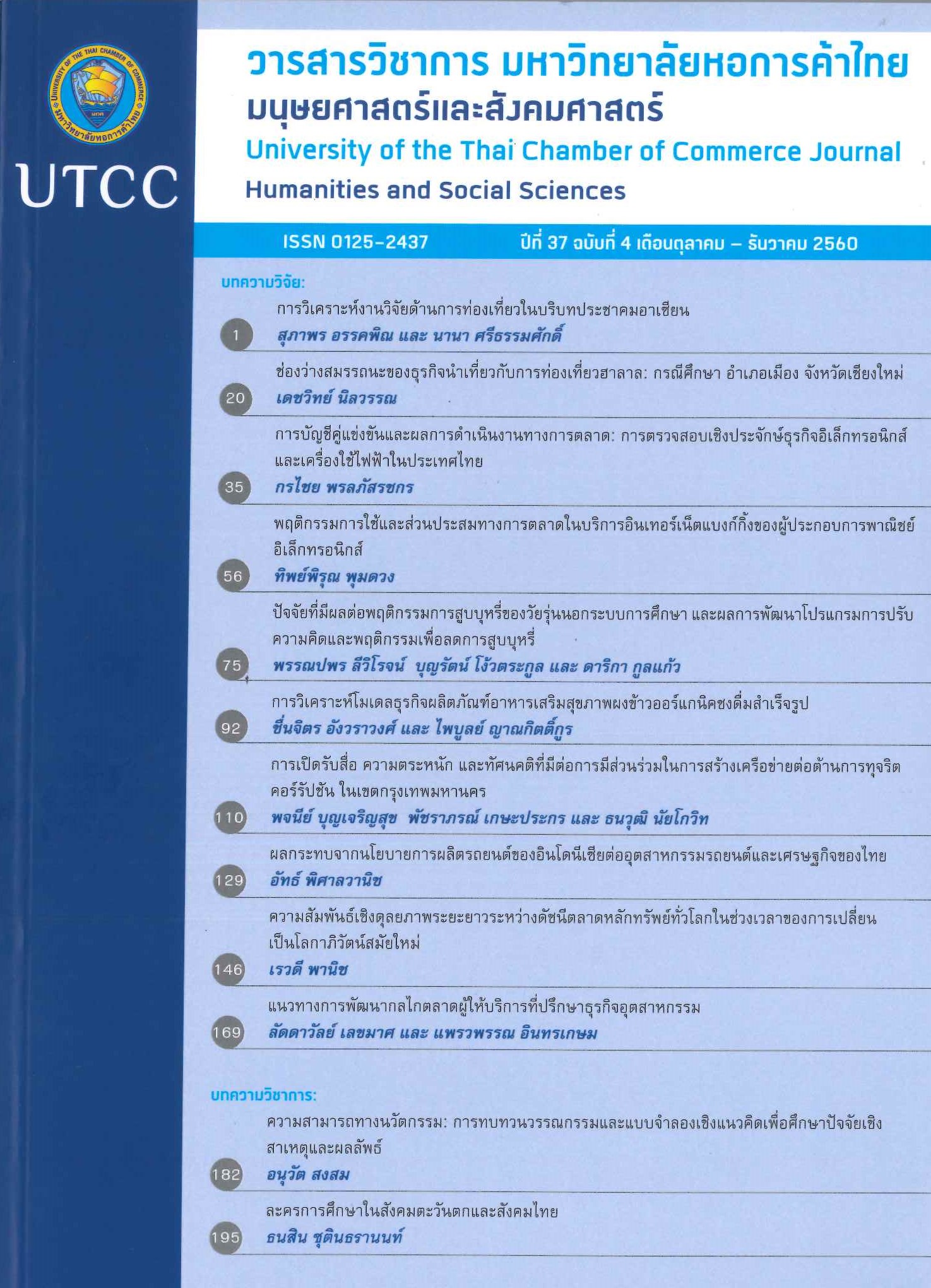The Impacts of Indonesia’s Automotive Production Policy on Automotive Industry and Economy of Thailand
Main Article Content
Abstract
This study aims to explore potential impacts on Thailand’s automotive and parts industry and overall economy if Indonesia could produce cars as targeted in its national automotive policy. To study the impacts of such policy, statistical tools and the views of entrepreneurs in the automotive and parts industry having trade and investment with Indonesia are taken into account. The study has 2 parts: the first part is the quantitative study which evaluates benefits and impacts on the automotive and parts industry of Thailand as well as to the overall economy of the country. The tools used for this evaluation are the Inter-Country Input-Output (ICIO) of the OECD, the Input-Output (IO) of the Office of National Economic and Social Development Board of Thailand, and the ASEAN macroeconomic forecasting model, which is developed by the Center for International Trade Studies of the University of the Thai Chamber of Commerce. The second part of the study is the qualitative analysis focusing on relevant entrepreneurs’ opinions on benefits, impacts, opportunities and challenges from the automotive production policy of Indonesia.
Article Details
ลิขสิทธิ์ของบทความ
ผลงานที่ได้รับการตีพิมพ์ถือเป็นลิขสิทธิ์ของมหาวิทยาลัยหอการค้าไทย ห้ามมิให้นำเนื้อหา ทัศนะ หรือข้อคิดเห็นใด ๆ ของผลงานไปทำซ้ำ ดัดแปลง หรือเผยแพร่ ไม่ว่าทั้งหมดหรือบางส่วนโดยไม่ได้รับอนุญาตเป็นลายลักษณ์อักษรจากมหาวิทยาลัยหอการค้าไทยก่อน
References
Asean Automotive Federation. (n.d.). Asean Automotive Statistics. Retrieved January 9, 2017, from https://www.asean-autofed.com/statistics.html
Asian Briefing. (n.d.). Master plan acceleration and expansion of Indonesia economic development 2011-2025. Retrieved March 11, 2017, from https://www.cancer-pain.org/
Asian Development Bank. (n.d.). Industrial policy in Indonesia. Retrieved January 9, 2017, from https://www.adb.org/ sites/default/files/publication/.../ewp-411.pdf
Boutros-Ghali, B. (1993). System of national accounts. New York, NY: United Nation.
Box, G. E. P., & Jenkins, G. M. (1976). Time series analysis forecasting and control.San Francisco, CA: Holden-Day.
Enders, W. (1995). Applied economics time series. New York, NY: Wiley.
Gujarati, D. N. (2003). Basic econometrics. (4th ed.). New York, NY: McGraw-Hill.
Office of the National Economic and Social Development Board. (2010). An I/O table approach of Thailand. Bangkok, Thailand:Author. (in Thai).
Organisation for Economic Co-operation and Development. (2015). Inter-Country Input-Output (ICIO) Tables. Paris, France:Author
Pindyck, R. S., & Rubinfeld, D. L. (1991). Econometric models & economic forecasts. (3rd ed.). New York, NY: McGraw-Hill
Pisanwanich, A. (2006a). Econometric. Bangkok,Thailand: C.M.S Digital Print Copy.(in Thai).
Pisanwanich, A. (2006b). Knowledge of national income Thailand. Bangkok, Thailand:C.M.S Digital Print Copy. (in Thai).
Pisanwanich, A. (2009a). An input-output table of the cluster of provinces in the mid-south of Thailand. University of Thai Chamber of Commerce Journal, 28(2),31-51. (in Thai).
Pisanwanich, A. (2009b). Social accounting matrix: SAM and input-output table to analyze the economic impact. Bangkok, Thailand: C.M.S Digital Print Copy.(in Thai).
Pisanwanich, A., Chaivijitmalakul, P., & Suratsavadee, W. (2016). Study opportunities and cooperation from policy and strategic industrial of ASEAN countries to Thailand industrial.
Bangkok, Thailand: C.M.S Digital Print Copy. (in Thai).
Pisanwanich, A., Punchalard, S., & Chaivijitmalakul, P. (2008). Study links the inputs and outputs of the production activities at the provincial level to the provincial plan. Bangkok, Thailand: C.M.S Digital Print Copy. (in Thai).
Sriboonchitta, S. (2004). Econometrics: Theory and applications. Nontaburi, Thailand: Sukhothai Thammathirat Open University,Faculty of Economics. (in Thai).
Studenmund, A. H. (1997). Using economics: A practical guide. (3rd ed.). Reading, MA:Addison-Wesley.
Thiraphong, V. (2001). Microeconomics: Theory and applications. Bangkok, Thailand: National Institute of Development Administration. (in Thai).
United Nations, Department of Economic and Social Affairs, Statistical Office. (1973). Input-output tables and analysis. New York, NY: Author.
University of Thai Chamber of Commerce, Center for International Trade Studies. (2006). Econometric models, international trade, quarterly of Thailand. Bangkok,Thailand: Author. (in Thai).
World Trade Organization. (2014). Trade policy review. Geneva, Switzerland: Author.


